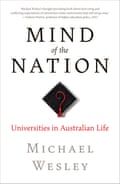Australia now has an opportunity to broaden access to university for disadvantaged groups in society. But, as we work towards an Australian universities accord at the end of this year, we face formidable obstacles. Over 50 years Australian governments have been trying to increase the number of disadvantaged Australians attending university with scant success. Even more galling, the general expansion in the number of Australians attending university has had the perverse effect of increasing, rather than decreasing, the stratification and inequalities within tertiary education.
Traditionally there have been two arguments in support of expanding access to university. One is that more tertiary-educated Australians will help expand and transition the economy; the other is that the economic and social mobility that university education brings should be open to all Australians.
Before the second world war Australian universities were the preserve of the wealthy; less than 0.2% of the population held a university qualification. Both the economic and equity rationales saw the steady expansion of the number going to university after the war; an expansion in scholarships; the creation of dozens of new universities and colleges of advanced education; the proliferation of professions that required a university qualification. By 1949, university attendance in Australia had tripled. By 2022, 49% of Australians between 25 and 64 had a tertiary qualification.
But while an increasing number of Australians were entering university mid last century, it was increasingly clear that the most marginalised and disadvantaged in the community were not.
The Whitlam government’s introduction of fee-free university attendance was motivated by a strong social justice rationale: making university available to all Australians by removing financial barriers.
The result was a surge in university attendance, but by the early 1980s, governments were facing the problem of unmet demand: Australians who were qualified to go to university exceeded available places. It started to become clear that the abolition of fees by the Whitlam government had not caused the huge rise in under-represented groups at universities that had been expected.
By 1990 the Labor education minister John Dawkins, having observed that significant barriers to inclusion remained, committed the government to “changing the balance of the student population to reflect more closely the composition of society as a whole”. His plan specified six disadvantaged groups as the focus for inclusion strategies, setting proportional representation targets for several: people from socioeconomically disadvantaged backgrounds; Aboriginal and Torres Strait Islander people; women; people from non-English-speaking backgrounds; people with disabilities; people from rural and isolated areas.
Where Whitlam’s attempt at social inclusion had failed, so did Dawkins’. Twenty years later, the education minister Julia Gillard commissioned former University of South Australia vice-chancellor Denise Bradley to again review the higher education sector. Bradley reported that the participation of disadvantaged groups in higher education had been “static and falling over the last decade.” She wrote that “Barriers to access for [disadvantaged] students include their previous educational attainment, no awareness of the long-term benefits of higher education and, thus, no aspiration to participate.”
Gillard’s efforts at inclusion, prompted by Bradley’s review, were no more successful than Whitlam’s or Dawkins’. The “demand-driven system” that Gillard introduced, resulted in a 70% increase in domestic undergraduate enrolments between 2008 and 2019, but achieved almost no proportional increase in disadvantaged groups’ attendance over that period. Students from low socioeconomic status backgrounds went from 15.8% to 16.8%; disabled students from 5.4% to 7.7%; Indigenous students from 1.5% to 1.9%; regional students declined from 20.7% to 19.6% remote students stayed at 0.8%; and students from non-English-speaking backgrounds declined from 3.4% to 3.2%.
Despite decades of government and university efforts to shift them, the patterns of correlation between socioeconomic advantage and university wealth and ranking have stayed stubbornly persistent.
Some analysts argue that the addressing of inequality has been too incremental, fiddling at the edges rather than addressing a systemic problem. Others point to the heavy reliance on tertiary entrance scores to select students as a barrier to access for under-represented groups. Numerical tertiary entrance scores provide a transparent, objective and comparable basis for selection, but they also conceal student advantage and disadvantage. And as competition intensifies for prestigious degrees and universities, tertiary entrance scores increase to manage demand, thereby privileging those with the economic, social and cultural capital to ensure their success at school.

An even more invidious and unintended consequence of the expansion of access to university has been the creation and exacerbation of the stratification and inequalities within our tertiary education landscape. As the Australian university sector has expanded enrolments and degree possibilities, it has become increasingly vertically differentiated. A significant reason is the role of higher education as a “status good”, a class of acquisitions the value of which is created by their scarcity. As economist Fred Hirsch pointed out, expanding access to a status good creates a hierarchy of value: more people may gain access to university places, but then some university places come to be seen as more prestigious than others.
This has driven and been reinforced by the rise of global university rankings, which motivate universities to invest in attributes that enhance their prestige value: research intensity, facilities, exclusivity, scholarships. The vertical stratification of the Australian university sector is a process that is driven by students and parents as much as by the universities themselves. As universities invest in their own prestige competition, students compete more intensely for degrees from those institutions or fields of study seen to be more prestigious and useful.
These are the challenges the education minister, Jason Clare, and accord review chair, Mary O’Kane, now face in their mission to expand access to Australian universities. They confront a formidable problem that has defeated generations of education policy reformers before them. It demands big ideas to solve the inclusion conundrum.
Michael Wesley is the deputy vice-chancellor, global, culture and engagement, at the University of Melbourne. His new book, Mind of the Nation: Universities in Australian Life, is published by La Trobe University Press and out now
